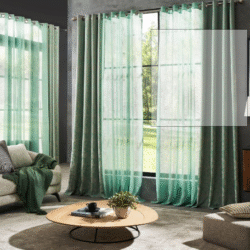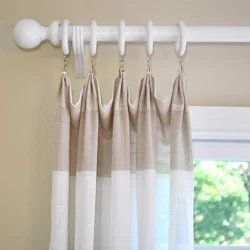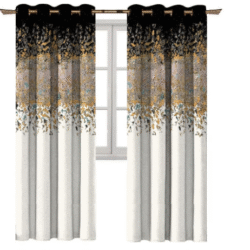curtain loops are an essential and stylish feature in modern window treatments. They serve both functional and decorative purposes, allowing curtains to hang gracefully and be easily adjusted. These loops, typically made from fabric, metal, or plastic, attach to curtain rods and enable smooth movement, giving curtains a neat and polished look. Curtain loops can be designed to match various interior styles, from classic to contemporary, offering flexibility in the design process. Whether you’re looking to create a relaxed, elegant atmosphere or a more structured, tailored appearance, curtain loops provide an effective way to enhance your living space. In this article, we’ll explore the different types of curtain loops, their benefits, and tips for choosing the best one for your home decor.
Creative Ideas for Incorporating Curtain Loops into Your Décor
Curtain loops can add both functionality and a touch of creativity to your home décor. These simple yet versatile accessories can be incorporated in several unique ways to enhance the aesthetic appeal of any room. One creative idea is using fabric loops that match the color or pattern of your curtains to create a seamless look. This can give your window treatments a soft, cohesive feel, blending beautifully with the rest of the room’s design. Alternatively, contrasting loops in bold colors or patterns can be used to add a pop of interest, drawing attention to the curtains as a statement piece.
Another idea is to use decorative metal or wooden loops to create a rustic or industrial vibe, particularly in living rooms or dining areas. These loops can complement natural wood furniture or metallic accents, giving the space a more polished, sophisticated look. For a more eclectic style, consider mixing different types of curtain loops, such as combining fabric loops with metal ones in a single room to add dimension and variety.
For a more functional approach, adjustable curtain loops can be used to allow for different curtain lengths, making it easy to change the appearance of a room depending on the season or your mood. Whether for their decorative value or practical benefits, curtain loops offer endless possibilities for customization, helping you to create a window treatment that perfectly complements your interior style.
What Are Curtain Loops?
Curtain loops are small, often fabric or metal rings or bands used to attach curtains to a curtain rod. They play a significant role in the overall function and appearance of window treatments. Curtain loops are typically sewn or attached to the top edge of curtains, allowing the fabric to hang neatly and evenly. These loops create a smooth, uniform appearance, and when used with curtain rods, they help the curtains slide easily for opening and closing.
Curtain loops come in various materials, including fabric, metal, plastic, and wood, each offering different aesthetic and functional benefits. Fabric loops, for example, provide a soft and tailored look, while metal loops can add an industrial or contemporary flair to the room. Additionally, some curtain loops are adjustable, enabling you to control the height of the curtains depending on your design preference or room layout.
The primary function of curtain loops is to hold the curtain securely in place while allowing for easy movement along the rod. They also ensure that the curtain hangs smoothly, without bunching or sagging, which is especially important for floor-length or heavy curtains. Overall, curtain loops are a simple yet effective addition to window treatments, contributing both to the functionality and style of any room.
Types of Curtain Loops: Fabric, Metal, and Plastic
Curtain loops come in various materials, each offering unique benefits and contributing to different interior styles. The most common types are fabric, metal, and plastic loops. Each material has its distinct characteristics, making it essential to choose the right one for your curtains and home décor.
Fabric loops are soft, versatile, and ideal for creating a more relaxed or traditional look. They are typically sewn directly onto the curtains, blending seamlessly with the fabric for a cohesive, soft appearance. Fabric loops work well with a wide variety of curtain styles, from casual to elegant, and they can be easily customized to match the color or pattern of the curtains. They are also great for heavier curtains, as the fabric is gentle on the material and allows for smooth movement.
Metal loops offer a more modern or industrial aesthetic. These loops are usually made of stainless steel, brass, or other metals, providing a sleek and sophisticated look. Metal loops are durable and strong, making them suitable for heavier or larger curtains. They also add a touch of elegance and can complement a contemporary, minimalistic design or industrial décor, where exposed metal elements are prominent.
Plastic loops are lightweight and affordable, making them a popular choice for budget-conscious homeowners. They come in various colors and finishes, allowing for versatility in design. While not as durable as metal, plastic loops are easy to install and maintain, offering a practical solution for lighter curtains or temporary setups. Each type of curtain loop offers a distinct look and functionality, allowing you to tailor your window treatments to your specific design preferences.
How to Install Curtain Loops for a Smooth Hanging Experience
- Choose the Right Curtain Rod: Ensure the rod fits the size and style of your curtain loops, allowing for smooth movement.
- Prepare the Curtains: Sew or attach the curtain loops evenly along the top edge of the curtains, making sure they are securely fastened.
- Measure and Mark: Measure the space between each loop to ensure uniformity and mark the spots where the loops will be attached.
- Install the Curtain Rod: Secure the curtain rod at the desired height on the wall, ensuring it is level and sturdy.
- Thread the Loops onto the Rod: Slide each loop onto the curtain rod one by one, making sure they glide smoothly.
- Adjust the Length: If necessary, adjust the curtain length or the placement of the loops for a perfect fit.
- Test the Curtains: Open and close the curtains to check if the loops allow for smooth sliding without bunching or sticking.
- Secure the Ends: Use end caps or tiebacks to keep the curtains in place and prevent them from slipping off the rod. By following these steps, you can ensure a smooth and seamless hanging experience for your curtains.
Choosing the Right Curtain Loop for Your Home Style
- Consider the Curtain Fabric: Choose fabric loops for soft, elegant curtains and metal or plastic loops for heavier or modern curtains.
- Match the Room’s Aesthetic: Use fabric loops for traditional or casual styles, metal loops for contemporary or industrial décor, and plastic loops for minimalist or budget-friendly designs.
- Assess the Curtain Weight: Select durable metal loops for heavy curtains and lightweight plastic loops for sheer or light fabrics.
- Select the Right Color: Ensure loop color complements the curtain shade—neutral loops work well with most colors, while bold loops can create a striking contrast.
- Check for Flexibility: Choose adjustable loops if you need flexibility in curtain length or positioning, especially for larger windows.
- Match with the Curtain Rod: Make sure the loop material and style complement your curtain rod’s design and finish for a cohesive look.
- Think About Durability: Metal loops are more durable for long-lasting use, while fabric and plastic may need replacement over time.
- By considering these factors, you can select the right curtain loops that enhance both the function and style of your home décor.
Decorative vs. Functional Curtain Loops
When choosing curtain loops, it’s important to consider their dual role in both functionality and aesthetics. Curtain loops can serve a purely functional purpose, ensuring that your curtains hang properly and slide smoothly along the rod. Functional loops are typically made from durable materials like plastic or metal and are designed to withstand the weight of heavy curtains while providing easy movement. These loops are often simple in design, with the primary goal being to support the curtains effectively and maintain a neat, structured appearance. They are ideal for spaces where the focus is on practicality, such as in offices or high-traffic areas, where ease of use is paramount.
On the other hand, decorative curtain loops focus more on enhancing the overall look of your curtains and room. These loops come in a wide range of materials, including decorative fabrics, metals, and even beaded or embellished options. Decorative loops are often used to add a touch of style, complementing the room’s décor and creating a cohesive, visually appealing window treatment. They are perfect for spaces where the aesthetic is as important as functionality, such as living rooms, bedrooms, or dining areas.
Ultimately, the choice between decorative and functional curtain loops depends on the specific needs of your space. You can even combine both elements by using functional loops with subtle decorative touches, achieving both practicality and style.
The Role of Curtain Loops in Enhancing Interior Design
- Adding Visual Appeal: Curtain loops can be a subtle design element that enhances the overall aesthetic of a room, complementing other decor features.
- Creating Uniformity: Well-placed loops ensure that curtains hang evenly, creating a neat and organized look that contributes to a polished interior.
- Complementing Room Style: Different loop materials, like fabric, metal, or wood, can align with various interior styles, from traditional to modern.
- Providing Texture and Depth: Decorative loops add texture to curtains, helping to create a layered and dynamic feel in the room’s design.
- Enhancing Functionality: In addition to their decorative role, curtain loops improve the movement and durability of curtains, adding both style and ease of use.
- Framing the Window: Loops help frame the window beautifully, drawing attention to it as a focal point in the room.
- Supporting Customization: Loops offer flexibility in curtain placement and length, allowing for customized looks that fit the specific design needs of the space.
- By incorporating curtain loops, you can significantly enhance your interior design while maintaining both style and functionality.
conclusion
In conclusion, curtain loops are a simple yet effective addition to window treatments that enhance both the functionality and aesthetics of any room. Whether you opt for fabric, metal, or plastic loops, they provide a practical solution for hanging curtains smoothly while offering endless possibilities for creativity in design. From adding visual interest and texture to ensuring that your curtains hang perfectly, curtain loops serve both decorative and functional purposes. By carefully selecting the right type of loop to match your home’s style, you can elevate the overall look of your space, making it feel more cohesive and well-designed. Ultimately, curtain loops are a versatile and essential element that can transform your window treatments into a beautiful and functional feature of your home décor.




